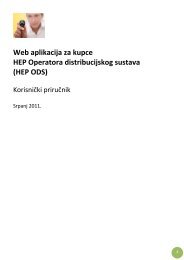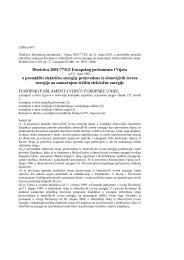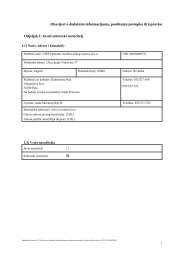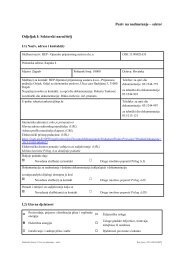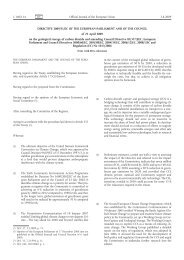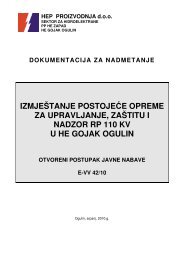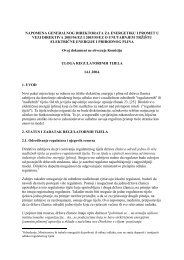Untitled
Untitled
Untitled
You also want an ePaper? Increase the reach of your titles
YUMPU automatically turns print PDFs into web optimized ePapers that Google loves.
ZakljuËak koji se moæe izvuÊi iz odgovora na pitanjaiz Upitnika je da regulatorna tijela ukoliko imajuu nadleænosti davanje suglasnosti na planoverazvoja/investicija OPS-a i ODS-a, u naËelu suglasnostdaju na moguÊnost realizacije predviappleenihinvesticija u financijskom pogledu te na rezultatekoji se postiæu predviappleenim investicijama. Podrezultatima smatra se poveÊanje uËinkovitostisubjekata koji obavljaju regulirane djelatnosti ilipoveÊanje razine kvalitete opskrbe. Ono πto jepotrebno naglasiti kao zakljuËak razmatranja odgovorana Upitnik je da se analizirana regulatornatijela ne mijeπaju u koncepcijska tehniËka rjeπenjau planovima razvoja i izgradnje mreæa.Da bi se moglo govoriti o poveÊanju uËinkovitostikoja je rezultat primjene poticajne regulacije i outjecaju razine odobrenih investicija na razinu dozvoljenogprihoda reguliranog subjekta, potrebnoje dati prikaz, odnosno analizu, moguÊih regulatornihpolitika u primjeni poticajne regulacije. Pritome vaænu ulogu ima osnovica na koju se primjenjujefaktor uËinkovitosti te dinamika realizacijepredviappleenih investicija i amortizacijska politika.3 UTJECAJ REGULATORNEPOLITIKE NA DOZVOLJENIPRIHODDo sada je bilo rijeËi o nadleænosti regulatornogtijela u donoπenju planova razvoja/investicija, a dase pri tome nije analizirala regulatorna politika ukojoj vaænu ulogu ima cilj koji se æeli postiÊi pojediniminvesticijskim ciklusom te razina odobrenihinvesticija koje se ukljuËuju u regulirane troπkove.Kontekst regulatorne politike koji se razmatra uovom Ëlanku prvenstveno se odnosi na poticajnuregulaciju Ëije su znaËajke u detalje razmatraneu literaturi pod [6], a za koju je, ukoliko se radi ometodi regulacije maksimalnog prihoda, karakteristiËnasljedeÊa formula:The conclusion that can be drawn from the responsesto the questions on the questionnaire is that the regulatorybodies, insofar as they have the authority to approvethe development/investment plans of the transmissionsystem operator and the distribution systemoperator, in principle issue approval based upon thefeasibility of the implementation of the planned investmentsin the financial aspect and based upon theresults to be achieved by the planned investments.Results include the increased efficiency of the entitiesperforming regulated activities or improved quality ofthe supply. It is necessary to emphasize that a conclusiondrawn from a review of the responses to thequestionnaire is that the analyzed regulatory bodiesdo not interfere in the conceptual technical solutionsof the network development and investment plans.In order to speak about the increased efficiency resultingfrom the application of incentive regulationsand the impact of the level of approved investmentson the level of the allowed revenue of entities performingregulated activities, it is necessary to providea presentation, i.e. an analysis, of the potentialregulatory policies in the application of incentiveregulations. Important roles are played by the baseupon which the efficiency factor is applied, thedynamics of the implementation of planned investmentsand the depreciation policy.3 THE IMPACT OF REGULATORYPOLICIES ON ALLOWEDREVENUEThus far, the authority of the regulatory body in theadoption of development/investment plans has beendiscussed without analyzing the regulatory policies, inwhich the desired goal to be achieved by an individualinvestment cycle and the level of approved investmentsincluded under regulated expenditures have importantroles. The context of the regulatory policies that arediscussed in this article primarily refers to incentiveregulation, the characteristics of which are discussedin detail in the literature [6], and for which, insofar asthey concern methods for the regulation of maximumrevenue, are characterized by the following formula:(1)gdje je:P max t ∑ gornja granica dozvoljenog prihoda ugodini t,where:R max t ∑ the upper limit of revenue, i.e. revenuecap,in year t,563Štritof,I., KleËina, F., Regulatorna politika i njen utjecaj ..., Energija, god. 56(2007), br. 5., str. 554-583Štritof, I., KleËina, F., Regulatory Polica and Its Impact ..., Energija, vol. 56(2007), No. 5, pp. 554-583



